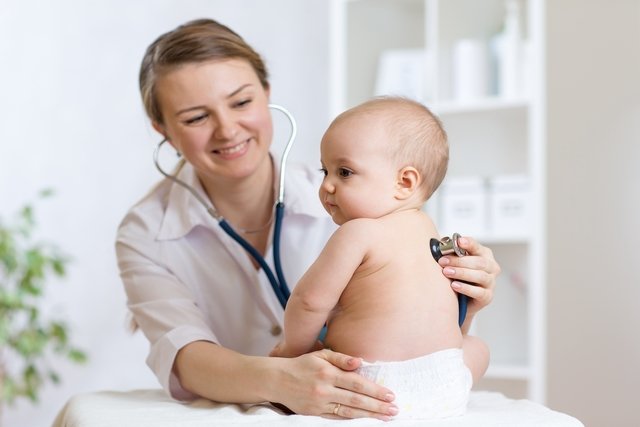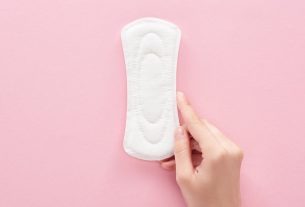The treatment of bronchiolitis at home involves measures that help alleviate the baby’s or child’s symptoms, such as rest, increased fluid supply, nasal hygiene or the use of medications recommended by the pediatrician.
Generally, it is not necessary to use antibiotics, as the disease is not caused by bacteria and there are no medications capable of eliminating the virus, as it is eliminated naturally by the body.
Bronchiolitis usually improves within 3 to 7 days, however, if the child or baby is having a lot of difficulty breathing, sinking of the rib or mouth muscles and purple fingers, it is recommended to quickly seek medical attention at a hospital. See the main symptoms of bronchiolitis.

How to take care of your baby at home
Complementary treatment for bronchiolitis that can be done at home includes:
1. Rest
Rest for your baby or child is important to help the body fight the virus and speed recovery.
Therefore, it is recommended to avoid going out with the baby or child or taking them to daycare or school.
2. Offer plenty of fluids
Offering plenty of fluids to your baby or child helps prevent dehydration and facilitates the elimination of the virus.
Therefore, for babies who are exclusively breastfed, breast and/or formula should be offered on demand.
For children who have already introduced food, water can also be offered.
3. Avoid places with a lot of dust
Avoiding places with a lot of dust or smoke is important to avoid worsening lung inflammation.
In addition, you must keep the baby’s room clean and airy, free from dust or mold, or objects that can accumulate dust, such as carpets, curtains, pillows or stuffed animals, for example, and wash the bedding frequently.
The baby should also avoid contact with cigarette smoke.
4. Keep the air humidified
To keep the air humidified, you can use a cold mist vaporizer, a humidifier or leaving a bowl of water in the room, out of the baby’s reach.
Humidified air is important to help fluidize respiratory secretions and relieve nasal congestion and coughing.
5. Clean the child’s nose
Cleaning the child’s nose frequently with drops of saline solution helps to make the secretion more liquid, facilitating its elimination and relieving nasal congestion.
These drops of saline solution (0.9% saline) can be used before feedings to facilitate the baby’s breathing, and whenever the nose is blocked, and should be applied with the baby sitting on your lap, with the head slightly tilted. back and never lying down.
In babies under 6 months of age, it is recommended to use the nasal bulb syringe. See other ways to unclog your baby’s nose.
6. Elevate the headboard
Elevating the head of the crib, placing a wedge over the head of the crib or using a crib lift, can help keep the airway open and aid breathing.
This should only be done with guidance from your pediatrician, and for babies over 12 months old, you can use a thin, low pillow, no more than 3 cm thick. Babies up to 1 year old should not use pillows.
7. Put the baby in a sitting position
When there is greater difficulty breathing, such as when breastfeeding, for example, it is recommended to place the baby in a sitting or standing position to facilitate breathing, as opposed to lying down.
These home measures must be maintained until symptoms disappear, which can take up to 3 weeks to happen. However, if there is no improvement in symptoms after 3 days, it is recommended to consult your pediatrician again.
Bronchiolitis remedies
It is generally not necessary to use medication to treat bronchiolitis, as the body is capable of eliminating the virus and preventing the disease from worsening.
However, when the symptoms are causing a lot of discomfort or the fever is very high, for example, the pediatrician may recommend the use of medicines, such as paracetamol or ibuprofen, with doses based on the baby’s weight and age.
Is important no give acetylsalicylic acid (Aspirin or AAS) to the baby or child as it can cause Reye’s syndrome. Find out what Reye’s syndrome is.
In some cases, the pediatrician may recommend the use of bronchodilators to open the airways and facilitate breathing, which should be done in the same way as the use of pressurized inhalers together with the expansion chamber.
Don’t ignore the signs your body is giving you!
What is the syrup for bronchiolitis?
The use of bronchiolitis syrups, to relieve coughing or wheezing, is discouraged by most doctors, as they do not bring benefits to the treatment, in addition to being unsafe for babies.
Signs of improvement
Signs of improvement in bronchiolitis usually appear around 3 to 7 days after starting treatment and include a decrease in fever, an increase in appetite and a reduction in difficulty breathing, however, the cough may still persist for a few more days or even months. .
When to go to the doctor
Although treatment can be done at home, it is advisable to go to the hospital when symptoms do not improve after 3 days or signs of worsening of the disease appear, such as:
- Very difficult to breathe;
- Very slow breathing or periods of pause;
- Rapid or panting breathing;
- Bluish lips and fingers;
- Sinking of the ribs;
- Refusal to breastfeed;
- High fever.
These cases are rarer and generally need to be treated in hospital to administer medication directly into the vein and receive oxygen.
Hospital treatment for bronchiolitis
Hospital treatment for bronchiolitis involves the use of intravenous fluids to maintain hydration or treat dehydration in the baby or child, and respiratory support such as humidified oxygen and nebulization with hypertonic saline.
Additionally, the doctor must monitor the vital signs and measure the oxygen saturation levels of the baby or child’s body.
In more severe cases, intensive respiratory care may be necessary, such as the use of mechanical ventilation or non-invasive ventilation. See how non-invasive ventilation is done.

Sign up for our newsletter and stay up to date with exclusive news
that can transform your routine!
Warning: Undefined array key "title" in /home/storelat/public_html/wp-content/plugins/link-whisper-premium/templates/frontend/related-posts.php on line 12
Warning: Undefined array key "title_tag" in /home/storelat/public_html/wp-content/plugins/link-whisper-premium/templates/frontend/related-posts.php on line 13



